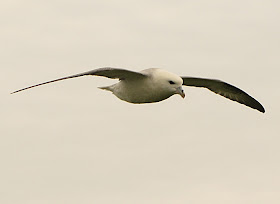Whilst on North Ronaldsay at the weekend over 100 Fulmars landed in tall vegetation at Bridesness and were caught for ringing. I went down there the next day under the impression that they had mistakenly gone into the vegetation and was amazed to watch birds deliberately landing in the iris and sedge beds. A good number were down in the vegetation and about 20 others were flying around them, every now and then one of the flying birds would land. Once in this vegetation they could not easily extricate themselves and were flapping around with no chance of flight. This would seem to be rather lemming like behaviour as in time a good number will surely die of starvation.
These birds were buzzing over the iris and sedge beds, occasionally landing
Not easy ground for a Fulmar
By coincidence we were eating this evening when we noticed a Fulmar on the front lawn. Being 7 miles or so from the sea and Fulmar being fairly infrequent here (first tetrad record this year) I was surprised. Having donned old clothes I went out and caught the bird. With there being almost no breeze attempts to launch it into the air met with failure, long glides and crashing back onto the grass. In the end we loaded the fulmar into a cat basket and took it to Pt of Buckquoy where there were plenty of other fulmars and a fair breeze, it flew off strongly once launched into the air.
First attempt to relaunch
This looks as if it might be successful... but no
I'm interested in this odd behaviour. Of the birds that were retraps or controls amongst the NRon birds I think I'm correct in stating they were all ringed in the last four years so were probably young and inexperienced. Could this be social behaviour, seeking out nest sites? Its hard to think of a reasonable
explanation.
The Shunan is full of water and unsuitable for much, even the Teal and Wigeon have deserted it of late. However, the field across the track to the east is now flooded in places and this has led to up to 17 Blackwits feeding in there. Yesterday there was a Ruff and 11 Redshank; a good spot for a Pec I should think.
The trip to North Ronaldsay was ok, considering the not so good winds. A seawatch produced 18 Sooties and the same number of Manx along with 7 Euro Stormies. There were plenty of the commoner waders moving and I connected with a couple of rather elusive Barred Warblers. I did spend the best part of three hours trying to see a Phyllosc that I'd glimpsed in Holland House gardens, to no avail, I'd fancied finding Arctic Warbler... maybe next time.









No comments:
Post a Comment